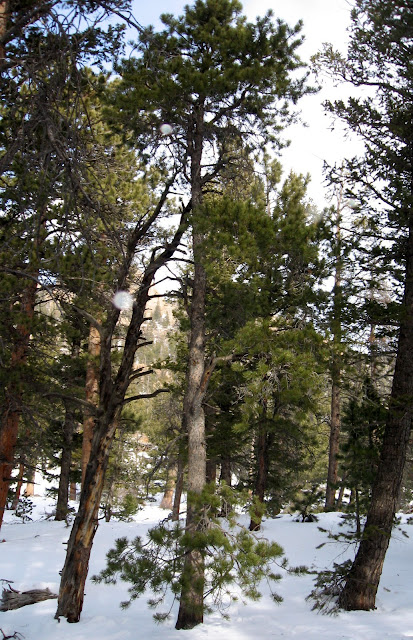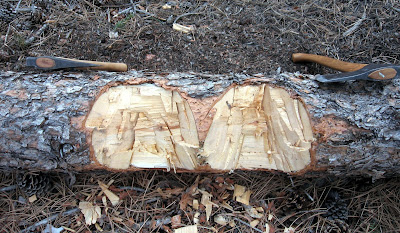to create what he felt would be a perfectly proportioned, highly functional, yet lightweight wilderness axe. His philosophy was to create an axe that was versatile enough to be a strong chopper and splitter, yet light enough to be carried long distances without putting an undue burden on pack weight.
As a Canadian outdoorsman and longtime axe-user, Les is one of a small circle of wilderness survival experts that I respect when it comes to axes, so I was curious to see how his new Bushman axe would measure up. We would like to say a special thanks to Matt Huff at
for offering us the opportunity to be the first to review the Bushman Axe.
The SPECS:
Overall length: 22" (our sample measured 21.75")
Head weight: 1.6 pounds
Overall Weight (without sheath): 37.6 ounces
Overall Weight (with sheath): 39.4 ounces
Steel type: Hand forged Swedish high carbon steel (composition unknown)
Cutting Surface: 3 3/8th inches
Handle type: American Hickory
Country of Origin: Made in Sweden
Warranty: None
Retail Price: $149.00
The Bushman Axe
features a hand forged, high carbon Swedish steel head which weighs in at 1.6
lbs. The handle is 22" long and made from American Hickory.
The Bushman Axe
sports a new, thinner Gransfors' style leather sheath, as do all
2012 Wetterlings axes. Overall the sheath seems sturdy enough, but the button is
not as robust or secure as those on older Wetterlings' sheaths or current
Gransfors' sheaths. On some of my other 2012 Wetterlings test axes, I've noticed
that the button unsnaps inside my pack or car trunk a little too easily. If
you're reading this Wetterlings, please return to the old style snap!
This profile design is very wedge shaped and thick in front of the eye towards the cutting bit, similar to a dedicated splitting axe. Wetterlings has also stopped using metal wedges in their small axes recently. According to Julia Kalthoff, CEO of Wetterlings, she wanted Wetterlings axes to conform to vintage axe manuals, which state that properly hung axes don't need metal wedges to secure the haft to the head. This sentiment is also backed up by axe expert Bernie Weisgerber in his book "
An Axe to Grind."
When compared to
other popular axes in the same category, this thicker profile really stands out.
In the first photo, the Bushman is shown in between Wetterlings' popular Large
Hunting and Forester's Fine axes:
From left to right: Wetterlings 2012 Swedish Forest Axe, Les Stroud Bushman Axe, Gransfors Bruks Scandinavian Forest Axe
Another interesting change is the new circular Wetterlings logo stamped into the head:
(click to enlarge)
The hammer poll:
Handle Grain/Quality/Alignment
The handle is mostly straight with a slight curve in the grip
area, and is slightly thicker than most Gransfors Bruks axe handles.
Before receiving
the Bushman axe, I thought from the preview photos that the handle would be the
biggest negative, since I generally don't like straight handles on smaller axes.
I was surprised to find that after using the Bushman, I was really impressed
with the handle. It's comfortable and feels good whether chopping or choking up
on it to do fine work.
The grain
direction is excellent, and the tightness of the grain about average:
The alignment is excellent:
Comparison Photos
The Bushman Axe (right) next to a Wetterlings Large Hunting Axe (left):
Comparison with a Wetterlings 2.2lb 2012 Swedish Forest Axe, 1.4lb Forester's Fine Axe, and a 1.75lb Gransfors Bruks Scandinavian Forest Axe:
(click to enlarge)
Balance
The Bushman axe
balances well along the handle, but the head is very unbalanced due to the small
hammer poll. Since Les wanted to emphasize splitting, this is an obvious
trade-off in order to make the cheeks thick enough to split well.
Out of the box, the
Bushman axe was very sharp, but just shy of shaving-sharp. A few swipes on a
ceramic sharpening rod quickly brought it up to speed.
For the field test, I wanted to focus on the four main features Les Stroud
extols in this axe- 1) Chopping ability 2) Splitting ability 3) Usefullness for
fine work, and 4) Portability
I didn't perform an official test with the hammer poll, but used it off
camera at my test location to pound wooden stakes into the ground, and it
functioned as advertised.
Chopping
Prior to the test below, I used the Bushman off-camera several times to get a
feel for it. My impression was that it was a rather vicious chopper for its
size, so I decided to pit it against a slightly larger Gransfors Bruks
Scandinavian Forest Axe. After pitting the two against each other, my suspicions
were confirmed. As you can see in the photos below, the Bushman chopped about
95% as well as the Gransfors.
(click to enlarge)
Splitting
To test the Bushman's splitting ability, I grabbed a healthy-sized Ponderosa
Pine log that had been cut by fire crews during an older forest fire in the
area, and split it in two. It was fire-hardened, so this was no easy feat.
(click to enlarge)
First swing:
Third swing:
Success! The Bushman splits almost as well as a real splitting axe.
The rest of the pieces were easily split with just one swing:
Fine carving
The Bushman axe
proved to be an excellent fine carving axe. The edge profile made controlled
cuts such as feathering easy, and the head and handle profile made the axe very
comfortable and controllable while performing this task.
Packability
The Bushman Axe was small enough to fit inside my
Kelty Redtail 30 Daypack. Given its excellent field performance, this means access to a lot of
"firepower" should the need arise out in the backcountry, even when traveling
light.
CONCLUSION
The Les Stroud Bushman Axe represents what I believe to be a good compromise in
a wilderness axe. What it gives up in absolute balance, it makes up for with
excellent splitting ability. Purists may not like this "pickaxe" balance aspect,
but I think it's a reasonable trade-off considering how well it splits. I don't
think the average axe user will be bothered by the head/poll balance issue very
much, since the haft balance is actually very good.
The Bushman axe
also turned out to be an excellent chopper and fine carver, almost out of
proportion for its size. The handle was surprisingly comfortable and secure in
the hand, proving that Les knows a thing or two about what it takes to make a
good backcountry axe handle.
Cons? Yes..... As
mentioned in the features section above, the button snap on the newer style
sheath is wimpy and needs to go. It unsnaps too easily if brushed up against
other gear inside a pack or car trunk. The forging, as evidenced in the photos
above, is still a bit sloppy and not up to Gransfors Bruks standards, important
considering that this axe is actually more expensive than a Gransfors Bruks
Scandinavian Forest Axe, which leads me to my third issue -- price. At $149.00
retail, the Bushman Axe is really pushing the bounds of affordability,
especially considering that it doesn't come with a warranty like Gransfors'
axes. For this price, it should come with a warranty, be shaving sharp out of
the box, have a sturdier snap on the sheath, and better symmetry on the
forging.
Even with the
issues mentioned, I still think the Bushman Axe is a first-rate wilderness tool
that deserves strong consideration for inclusion in your axe collection. Not to
mention the "cool factor" of owning an axe personally designed by the
"Survivorman" himself.
Dec 22nd, 2012 UPDATE: Wetterlings has informed us that they offer lifetime warranties on all their axes. Wetterlings has no written policy on their site or on the literature that comes with the axes, so if you have a problem, my best guess is to contact the Wetterlings dealer that sold the axe to you.
February 9th, 2013 UPDATE: Les Stroud Bushman Axe Issues\Conversation with Julia Kalthoff
April 22nd, 2013 UPDATE: After resharpening the rolled/dented edge on the Bushman Axe and chopping with it several times, it appears to have held up well. I plan to test a newer model to see if the issues have been fully resolved, but until then, recommend this axe with the reservation that it may need to re-sharpened or re-profiled, if an issue should develop.
About the author
 Jason Schwartz is the founder and senior editor of Rocky Mountain Bushcraft, a blog that features articles, news stories, outdoor tips and product reviews written from a bushcraft and wilderness survival perspective. Schwartz is a former Red Cross certified Wilderness & Remote First Aid Instructor and has taught bushcraft and wilderness survival techniques to the Boy Scouts of America. He has also written for the The New Pioneer and Backpacker, including writing the "Tinder Finder" portion of Backpacker's
Jason Schwartz is the founder and senior editor of Rocky Mountain Bushcraft, a blog that features articles, news stories, outdoor tips and product reviews written from a bushcraft and wilderness survival perspective. Schwartz is a former Red Cross certified Wilderness & Remote First Aid Instructor and has taught bushcraft and wilderness survival techniques to the Boy Scouts of America. He has also written for the The New Pioneer and Backpacker, including writing the "Tinder Finder" portion of Backpacker's "
Complete Guide to Fire," which won a 2015 National Magazine Award (NMA). Email him at rockymountainbushcraft @ hotmail.com (without spaces)


































































